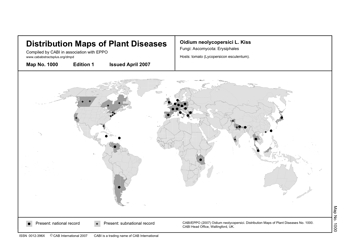The latest edition of a relatively new blog carnival called Oekologie — very groovy — is up at Behavioral Ecology Blog. There’s not an awful lot of direct agricultural interest. A post from GrrrlScientist summarizes a study on the evolution of Soay sheep on the island of Hirta in the Outer Hebrides (not) near Scotland. Cold winters select larger sheep, which selects for fewer sheep. But not all winters are that cold. On the indirect front, there are an awful lot of posts on climate change, including the one from our own Andy Jarvis, which Oekologie compiler Matt admits he found “too depressing … to read”. Shame on you Matt, but thanks for the carnival.
What’s so special about Oidium neolycopersici?
It’s a disease that affects mostly tomatoes, more commonly known as tomato powdery mildew. It has only recently been identified as a separate species. And it is the 1000th disease to be mapped by CABI, a fact we noted from CABI’s blog.

Distribution Maps of Plant Diseases is a series that has been going since 1942. To view the maps you need to subscribe, although CABI has generously made map no. 1000 available free 1. There’s also a collection of Distribution Maps of Plant Pests. Apparently, many of the maps have been drawn up more than once. What I’d really like to see would be time series animations showing how pests and diseases have moved around the world in recent years, what with climate change, air travel and a host of other contributory factors. How about it CABI?
Tangled Bank
Tangled Bank No. 77 is up at Aetiology, with its usual selection of blog-posts on biology in general. That includes Andy Jarvis’ piece on climate change here, and also news that chimpanzees may have been using tools — stones to crack nuts — for more than 4000 years. That doesn’t quite make them proto-hunter gatherers, but it is somewhat mind-blowing that the scientists were able to identify a bunch of stones as tools.
Gardens of Agricultural Biodiversity
From the Sarawak Biodiversity Centre, news of the ethnobotany garden. Dr Francis Ng reports that the half-hectare garden, which he designed, is flourishing, and that eventually he hopes to have more than 500 species — including Musa lokok, a previously unknown banana species — used by the local people on hand to study. The garden is close to the Orang Utan Centre at Semengok and has already been visited by schoolchildren. Eventually, Dr Ng says, tourists will be able to visit. Gardens of useful plants strike me as an excellent way to promote the virtues of agricultural biodiversity in a local context. I know of a couple, at Nabk in Syria and the Potato Park near Cusco, Peru, but there must be others.
Specialized search
From IAALD, news of a specialized search engine. The Plant Management Network — a gathering of mostly land grant colleges in the US, by the look of it — has a single point of entry to search the information of all members of the network. I’m not sure how useful this will be, as I don’t have any genuine queries to make, and it seems very US biased, but someone out there might find it useful.